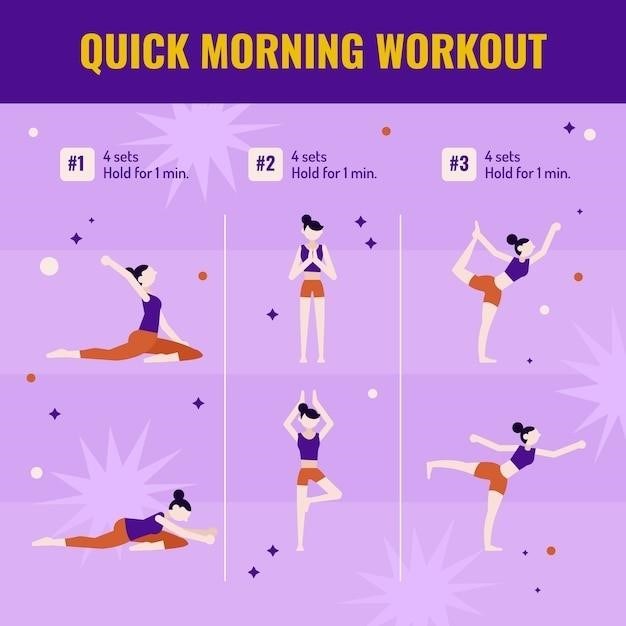Tendon Gliding Exercises⁚ A Guide to Improved Hand Function
Tendon gliding exercises are a series of movements designed to improve the flexibility and mobility of the tendons in your hand and wrist. These exercises are often recommended for individuals who have experienced hand injuries, surgery, or conditions like carpal tunnel syndrome. They can also help prevent repetitive strain injuries and improve overall hand function.
What are Tendon Gliding Exercises?
Tendon gliding exercises are a series of movements designed to enhance the flexibility and mobility of the tendons in your hand and wrist. These exercises are often recommended for individuals who have experienced hand injuries, surgery, or conditions like carpal tunnel syndrome. They can also help prevent repetitive strain injuries and improve overall hand function. These exercises work by gently moving the tendons through their full range of motion, helping to prevent adhesions, improve blood flow, and reduce stiffness. They are often used in conjunction with other hand therapy techniques, such as stretching and strengthening exercises.
Benefits of Tendon Gliding Exercises
Tendon gliding exercises offer a range of benefits for those seeking to improve hand function and reduce discomfort. They can help to improve range of motion in the hand and fingers, allowing for greater flexibility and dexterity. By promoting smooth tendon gliding, these exercises help to prevent adhesions, which can form after injury or surgery and restrict movement. This increased mobility can significantly enhance grip strength and fine motor skills, making everyday tasks easier to perform. Moreover, tendon gliding exercises contribute to reducing hand swelling and inflammation, easing pain and discomfort associated with various hand conditions.
Types of Tendon Gliding Exercises
Tendon gliding exercises encompass a variety of movements targeting specific tendon groups in the hand. These exercises are typically categorized by the position of the fingers and wrist, ensuring that each tendon is effectively engaged. Common examples include the Straight Finger Exercise, where the fingers are extended while the wrist remains straight, and the Hook Fist Exercise, which involves bending the fingers into a hook shape while keeping the wrist straight. The Full Fist Exercise requires making a tight fist with all fingers, while the Table Top Exercise involves placing the hand flat on a table with the fingers extended. Finally, the Straight Fist Exercise involves making a fist with the fingers straight, promoting gliding in a different plane compared to the Full Fist Exercise.
Straight Finger Exercise
The Straight Finger Exercise is a fundamental tendon gliding exercise that focuses on isolating the movement of the extensor tendons. To perform this exercise, start with your hand and wrist in a neutral position, fingers extended and straight. Keeping your wrist straight, gently bend the top joint of each finger, bringing the fingertip towards the palm. Hold this position for a few seconds, then slowly straighten the finger back out. Repeat this movement for each finger individually, ensuring that the other fingers remain straight. This exercise helps to improve the gliding of the extensor tendons, promoting flexibility and range of motion in the fingers.
Hook Fist Exercise
The Hook Fist Exercise targets the flexor tendons responsible for bending the fingers. Begin with your hand in a neutral position, fingers extended. Then, curl the tips of your fingers into a hook shape, as if you were holding a small object. Ensure that only the top joint of each finger is bent, keeping the middle and bottom joints straight. Hold this position for a few seconds, then slowly straighten your fingers back out; Repeat this movement several times. This exercise helps to improve the gliding of the flexor tendons, promoting flexibility and range of motion in the fingers, particularly at the top joint.
Full Fist Exercise
The Full Fist Exercise engages a wider range of flexor tendons, promoting overall hand strength and flexibility. Start with your hand in a neutral position, fingers extended. Then, make a tight fist, ensuring that all four fingers are curled tightly into your palm. Keep your thumb straight and extended across the top of your fingers. Hold this position for a few seconds, then slowly release your fingers, extending them back to their starting position. Repeat this movement several times. This exercise helps improve the gliding of the flexor tendons, enhancing the ability to make a strong, closed fist and increasing the range of motion in the fingers and wrist.
Table Top Exercise
The Table Top Exercise targets the extensor tendons, particularly the extensor digitorum communis, which are responsible for extending your fingers. Begin by placing your forearm on a table, with your hand extending over the edge. Keep your wrist straight and fingers extended. Then, slowly raise your fingers towards the ceiling, keeping your wrist straight and stationary. Hold this position for a few seconds, then gently lower your fingers back down to the table. Repeat this movement several times. This exercise promotes the gliding of the extensor tendons, improving the ability to straighten your fingers and increasing the range of motion in your wrist.
Straight Fist Exercise
The Straight Fist Exercise focuses on the flexor tendons, specifically the flexor digitorum superficialis (FDS) and flexor digitorum profundus (FDP), which are responsible for bending your fingers. Start with your hand in a neutral position, fingers extended and wrist straight. Next, gently make a fist, ensuring that all your fingers are curled inwards, but keep your thumb extended. Hold this fist position for a few seconds, then slowly open your hand, extending your fingers back to the starting position. This exercise helps improve the gliding of the flexor tendons, enhancing the ability to make a fist and improving overall finger dexterity.
How to Perform Tendon Gliding Exercises
Performing tendon gliding exercises correctly is crucial for maximizing their benefits and avoiding potential strain. Begin by finding a comfortable and well-lit area where you can sit or stand with your arm resting on a table or a stable surface. Ensure your hand is relaxed and your fingers are straight. When performing each exercise, focus on slow and controlled movements, avoiding any sudden jerks or forceful actions. Pay attention to your body and stop if you experience any pain. If you are unsure about the correct technique, it’s best to consult with a healthcare professional or a hand therapist for guidance. Regular practice and consistency are key to seeing improvement in your hand function.
Frequency and Duration
The frequency and duration of tendon gliding exercises vary depending on individual needs and the underlying condition. For most people, performing the exercises 3-4 times a day is recommended. Each session should consist of several repetitions of each exercise, with each repetition held for 3-5 seconds. Start with a shorter duration and gradually increase the time as your hand strength and flexibility improve. It’s important to listen to your body and stop if you feel any pain or discomfort. Remember, consistency is key, so try to incorporate tendon gliding exercises into your daily routine for optimal results.

Tendon Gliding Exercises for Specific Conditions
Tendon gliding exercises can be particularly beneficial for individuals dealing with specific hand conditions. For example, they are often recommended for those with carpal tunnel syndrome, as they help to improve the gliding of the tendons through the carpal tunnel, reducing pressure on the median nerve. These exercises can also be helpful for post-surgery rehabilitation, promoting the healing process and restoring hand function after procedures like flexor-tendon reconstruction. Moreover, tendon gliding exercises can be incorporated into a rehabilitation program for hand injuries, aiding in reducing stiffness and improving range of motion. Always consult with a healthcare professional to determine the most appropriate exercises for your specific condition.
Carpal Tunnel Syndrome
Carpal tunnel syndrome (CTS) is a common condition that affects the median nerve, which runs through the carpal tunnel in the wrist. This condition can cause pain, numbness, and tingling in the hand and fingers. Tendon gliding exercises are often recommended for individuals with CTS, as they can help to improve the gliding of the tendons through the carpal tunnel, reducing pressure on the median nerve. These exercises can help to alleviate symptoms and improve hand function in those with CTS. Research suggests that tendon gliding exercises, along with other therapies, may be beneficial in managing symptoms and improving hand function in individuals with carpal tunnel syndrome. Remember to consult with a healthcare professional to determine the most appropriate exercises for your specific needs.
Hand Injuries
Hand injuries, whether from trauma, surgery, or repetitive strain, can often lead to stiffness, pain, and limited range of motion. Tendon gliding exercises play a crucial role in hand injury rehabilitation. These exercises promote smooth gliding of the tendons within their sheaths, reducing adhesions and scar tissue formation. By improving tendon mobility, these exercises help restore hand function, reduce pain, and improve grip strength. The exercises are often incorporated into hand therapy programs to facilitate healing and regain dexterity. Remember to consult with a hand therapist or healthcare professional to receive personalized guidance and ensure proper technique for safe and effective rehabilitation.
Post-Surgery Rehabilitation
Following hand surgery, whether for tendon repair, fracture fixation, or other procedures, tendon gliding exercises are essential for a successful recovery. These exercises help prevent scar tissue from forming, promote tendon gliding, and enhance range of motion. They are typically incorporated into post-surgical rehabilitation programs, alongside other therapies like occupational therapy. The exercises are designed to gradually increase the range of motion and strength in the affected hand. It is important to start with gentle movements and progress as the hand heals. Regularly performing these exercises can significantly contribute to achieving optimal hand function and reducing the risk of post-surgical complications.
Safety Precautions
While tendon gliding exercises are generally safe, it is crucial to follow some safety precautions to avoid potential complications. If you experience any pain, stop the exercise immediately and consult with your doctor or therapist. Avoid pushing yourself beyond your limits, as excessive strain can cause further injury; It’s important to listen to your body and gradually increase the intensity and duration of the exercises as your hand heals. Avoid performing the exercises if you have an open wound or infection. Always consult with your doctor or therapist before starting any new exercise program, especially after an injury or surgery. They can provide personalized guidance and ensure the exercises are appropriate for your specific condition.
Tendon gliding exercises are an essential tool for improving hand function and promoting recovery after injuries or surgery. They help to restore flexibility, reduce stiffness, and enhance overall hand mobility. These exercises are often incorporated into rehabilitation programs for conditions like carpal tunnel syndrome, hand injuries, and post-operative rehabilitation. By incorporating tendon gliding exercises into your daily routine, you can improve your hand dexterity, reduce pain, and enhance your overall quality of life. Remember to consult with your doctor or therapist for personalized guidance and to ensure you are performing the exercises correctly and safely.


